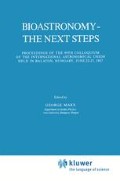Abstract
Using the first optical observatory in space, the Hubble Space Telescope, images of possible extrasolar planets will have poor contrast against the background of diffracted and scattered starlight. The very long exposure time required to achieve an adequate signal-to-noise ratio will make their detection infeasible. For a future telescope, a 16-fold increase in either the smoothness or the collecting area of the optics would reduce the exposure time to a tolerable value, but the contrast would remain low and the required photometric precision high. In this situation, the feasibility of detection would be contingent on the careful identification and control of systematic errors.
Access this chapter
Tax calculation will be finalised at checkout
Purchases are for personal use only
Preview
Unable to display preview. Download preview PDF.
References
Brown, R. A., and Burrows, C. J. ‘On the feasibility of direct planet detection using Hubble Space Telescope.’ Icarus (submitted).
Terrile, R. J. ‘Direct imaging of extra-solar planetary systems with a low-scattered light telescope.’ Bioastronomy — The Next Steps: Proceedings of IAU Colloquium No. 99 (G. Marx, ed.) 1988.
Hubbard, W. B. Planetary Interiors. Van Nostrand Reinhold: New York, 1984, pp. 236–240.
Mauron, N. ’Haute Resolution Angulaire et Coronographie en Astronomie Spatiale: Etude Theorique et Experimentale du Mode Coronographique de la “Faint Object Camera.” ‘Unpublished thesis at Université de Droit, d’Economie et des Sciences d’Aix-Marseille, 1980.
Macchetto, F. ‘The Faint Object Camera.’ The Space Telescope Observatory: Proceedings of the Special Session of Commission 44, IAU 18th General Assembly (D. N. B. Hall, ed.) 1982, pp. 40–54.
Author information
Authors and Affiliations
Editor information
Editors and Affiliations
Rights and permissions
Copyright information
© 1988 Kluwer Academic Publishers
About this paper
Cite this paper
Brown, R.A. (1988). Systematic Aspects of Direct Extrasolar Planet Detection. In: Marx, G. (eds) Bioastronomy — The Next Steps. Astrophysics and Space Science Library, vol 144. Springer, Dordrecht. https://doi.org/10.1007/978-94-009-2959-3_17
Download citation
DOI: https://doi.org/10.1007/978-94-009-2959-3_17
Publisher Name: Springer, Dordrecht
Print ISBN: 978-94-010-7830-6
Online ISBN: 978-94-009-2959-3
eBook Packages: Springer Book Archive

